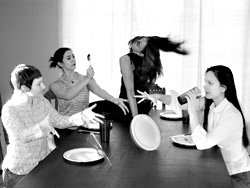Lately, artists seem to be following Winnie-the-Pooh’s advice and having “a little something” to sustain them. Unlike dinner theaters of the past, with their choice of prime rib or chicken in a sauce followed by light entertainment starring a waning celebrity, the current mix of food and festival is more daring, on the plate and on the stage. Lingo dancetheater’s contribution to this development is Nourish, an evening that incorporates a little food, a little film, and a little dance.
Lingo director KT Niehoff’s inspiration for the program was pragmatic—she had a 20-minute work she wanted to show, but that wasn’t long enough for a stand-alone program. With the 10th anniversary of Velocity Dance Center coming up, she began to think about how her neighborhood had changed most, and restaurants jumped to the top of the list. She approached some of her favorites, and five said yes.
For opening night last Friday, Niehoff only had to cross the hallway to the Century Ballroom and Cafe in the Odd Fellows Building, where on separate nights Via Tribunali, Lark, Elysian Brewing Company, and 1200 Bistro and Lounge feature samples from their menus. Opening night, the Century’s chef, Lisa Iannini, brought crab-filled wontons, a Greek variation on pizza, and a succulent risotto—matched with a glass of wine. The atmosphere at the little tables scattered around the performing space was much more genial than the usual contemporary dance concert vibe.
Niehoff’s new dance was commissioned by Cleveland’s GroundWorks Dancetheater, and footage from that residency was intercut by videographer Ephraim Peniston with materials shot while Niehoff taught the work here. One of the pleasures of watching rehearsals, live or on tape, is seeing dancers begin to inhabit a new physical creation. As they try to capture the elegant flexibility in a fast undulation, they begin by only showing the start and the finish—it takes practice to find the rapid-fire sequence in the middle. The repetition that is rehearsal is multiplied by Peniston’s film editing, creating a tension that the live dance feeds on.
Despite the evening’s food-service connections, Niehoff’s Tipping Point doesn’t seem to have anything to do with waiting tables. Instead, it could be drawing from Malcolm Gladwell’s book of the same name, speculating about how small shifts in the environment can bring on large changes. Niehoff sets up an agitated vocabulary of small weight shifts and repetitive gestures, and manipulates it relentlessly. Five women, seated on the floor, each in her own square of light, spend 20 minutes fidgeting, shaking, and shoving themselves off the floor only to get right back down again. Their struggles are performed with a matter-of-fact fierceness, and we are anxious for them to be finished long before they are ready to be done. As they ring small changes on their restless phrases, they bring a formal development to what might otherwise feel like a seizure. This is cleanly crafted nervous energy.
After several years of creating large-scale spectacles, Niehoff has made a couple of small, tight works this year. Tipping Point and Study #1 (premiered last month for Spectrum Dance Theater) are both kinetically evocative and even more powerful for the clear boundaries she places on the material and performance. In an interview before the 2005 Relatively Real, Niehoff wondered if dance could actually do everything she wanted to accomplish as an artist. If she continues in this vein, the answer is a resounding yes.








